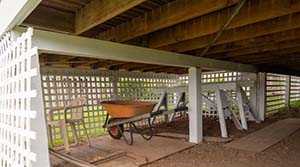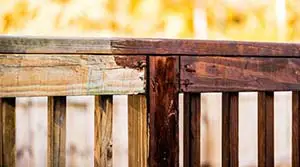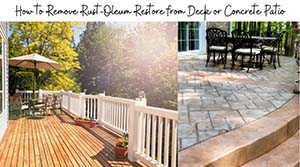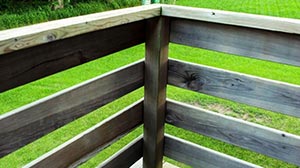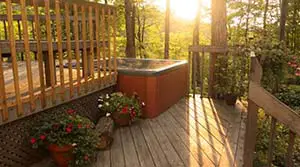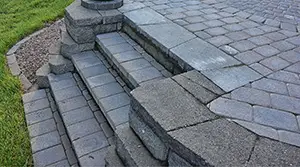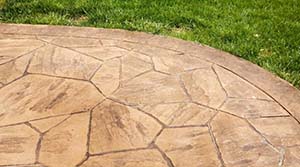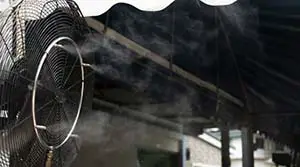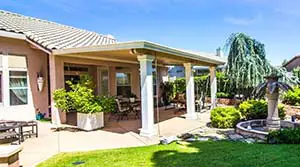
Rust-Oleum Deck and Concrete Restore deck paint has come under fire recently for peeling and cracking on decks or concrete patios before the 10-year warranty is up.
If your Rust-Oleum Restore deck paint is cracking and peeling, you might be wondering how to remove it from your deck or concrete patio.
To remove defective Rust-Oleum Restore paint, boil water, and scrape the deck. In some cases, replacing the decking boards may ultimately be cheaper in both time and money.
If your Rust-Oleum Restore is peeling, this is probably due to a product defect. The product can be painted over with stains, a different brand of paint, or another coat of Rust-Oleum 10x or 4x Restore.
Many unhappy customers who used the Rust-Oleum Restore family of products want a refund. Read on to discover potential remedies to the problems and why you might have to remove the product if it seems to be working correctly.
What is Rust-Oleum Restore?
Rust-Oleum Restore is a deck and concrete repair coating ten times thicker than paint and advertised to last ten years. The best time to apply Rust-Oleum Restore is when:
- Rain is not forecast within two days or 48 hours
- The temperature will be below 50 degrees or above 90 degrees
- When the deck or patio has no direct afternoon sun exposure
If you apply it any other time, the quality of the finish may be affected while it sets. A single can of Restore covers 25 square feet with two coats.
The product goes on thick and fills in cracks to protect your deck or patio from future wear and tear. So, it needs time to dry and fully cure.
Rust-Oleum Restore worked and did not work on the following surfaces:
| Surface | Can Restore Be Used? |
|---|---|
| – Sound wood – Composite surfaces | Yes |
| – Floated concrete – Fiberglass – Tile – Metal surfaces | No |
How Do You Remove or Paint Over Rust-Oleum Restore?
You might need to remove the product if it starts to crack and peel. It might also rot your deck boards. Rust-Oleum advises you to use a Wolman Deckstrip ASR or a stripper with sodium hydroxide.
While this advice seems simple, other customers found they used more extreme methods. Here are 4 methods customers have used to remove Rust-Oleum Restore:
- Use boiling water and a putty knife to take off Rust-Oleum Restore from railings.
- A power washer set at a high PSI takes off Rust-Oleum Restore, but it may leave damage.
- An amp grinder set at high with a bristle attachment removes the product, however, it will take days to get it all off. The process could cause the deck boards to splinter or flake.
- A propane torch with a scraper burns Rust-Oleum Restore off.
Rust-Oleum also advises that water-based floor paint, solid acrylic paint, or another coat of Restore 10X or 4X will cover the product. However, you need to clean the surface thoroughly first.
What Went Wrong with Rust-Oleum Restore?
Many dissatisfied customers prepared their deck, replaced deck boards, and applied Rust-Oleum Restore. The application of this product destroyed the deck wood.
The damage from the product required the replacement and removal of the deck wood and meant that they had to either start the restoration process over or completely replace their deck due to the damage.
The simple removal process provided by the manufacturer did not work in many cases. As a result, many customers were upset.
The first sign of damage came when beads or bubbles in the coating formed under the deck boards. This sign was usually visible several months after the customer used the product.
It indicated the presence of an air bubble or liquid under the Restore surface. This indication led to further problems as the product splintered and came off in sheets, which damaged the deck.
Some consumers reported thousands of dollars of damage to their deck, including supplies they bought and needed to start the deck restoration process over from scratch.
The problem might be in the hardening process. According to Rust-Oleum, the Restore will harden within three to five weeks.
For many, the product never fully solidified, and instead, the process resulted in a rubbery, soft finish. The texture seems closer to a pour-in-place rubber filling. Playground safety surfaces often use this texture.
The material might also be porous and trap moisture. The material caused deck boards to rot, with the damage hidden under the Restore surface.
If Rust-Oleum is still working on your deck, you may need to remove it. Read on to discover why.
Why Would I Remove Rust-Oleum Restore?
Removing Rust-Oleum Restore will help you avoid problems such as:
- Deck wood coming off in sheets along with the Restore
- Softening of deck wood
- Paint coming off of steps
- Rotted wood
In short, Rust-Oleum Restore does not restore your deck and will undo the hard work you did to repair it. These problems were so problematic that Home Depot voluntarily recalled the product from its shelves in California.
Rust-Oleum Restore contains Crystalline Silica, which can damage your lungs and is a known carcinogen. The precautions that the manufacturer lists on their website include:
| Issue | Action |
|---|---|
| Long-Term Overexposure | Crystalline Silica could be released by roughening or sanding the dry film. A room with good ventilation will avoid this problem. |
| Inadequate Ventilation | Use a NIOSH-approved particulate respirator. |
Why 3 Class Actions Were Filed Against Rust-Oleum & Rust-Oleum Restore?
1. Nancy Cole v. Rust-Oleum Corporation
In 2021, Nancy Cole sued Rust-Oleum Corporation. This suit, captioned as Nancy Cole v. Rust-Oleum Corporation, alleged that Rust-Oleum had misrepresented the effectiveness of their product.
The suit also alleged that Rust-Oleum Restore failed presale tests that showed a defect.
Finally, the lawsuit alleged that Rust-Oleum does not pay for repairs caused by their product even though the company offered exchanges for either similar Restore products or offered a refund as a remedy. The suit seeks to make the company pay $10,000 per individual affected by Rust-Oleum Restore.
2. Allan Gerrard v. Rust-Oleum Corporation
In 2019, plaintiff Allan Gerrard filed a class-action lawsuit against Rust-Oleum. The case, captioned Allan Gerrard v. Rust-Oleum Corporation, contained a class of 1,600 customers.
Gerrard sued Rust-Oleum because the deck paint was peeling and wearing out before the 10-year guarantee was up.
In one instance, it only took one year before the Rust-Oleum Restore started wearing out. The class action further alleged that Rust-Oleum knew or should have known about the issues. Finally, the suit alleged that the products were valueless and that customers were overpaying for the product.
3. In Re: Rust-Oleum Restore Marketing Practices and Products Liability Legislation
Both lawsuits are similar to a 2016 case captioned In Re: Rust-Oleum Restore Marketing Practices and Products Liability Legislation, which alleged that Rust-Oleum misrepresented how effective their Restore products were and concealed knowledge that was crucial to how the product worked.
It further alleged that Rust-Oleum knew that its deck paint was more likely to prematurely chip, degrade, or peel even though the company said its product was superior to others on the market. Rust-Oleum agreed to pay out $9.3 million for this settlement.
Here is a table of the products that were involved in each lawsuit.
| Products | Cases |
|---|---|
| Rust-Oleum Restore Deck Start Wood PrimerRestore 2X One Coat Solid StainRestore 4X Deck Coat | Nancy Cole v. Rust-Oleum Corporation (2021) |
| Rust-Oleum Deck and Concrete RestoreRust-Oleum 10X Products | In Re: Rust-Oleum Restore Marketing Practices and Products Liability Legislation (2016, Settled for $9.3 million) |
| Rust-Oleum Deck Start Wood PrimerRestore 2X One Coat Solid StainRestore 4X Deck Coat | Allan Gerrard v. Rust-Oleum Corporation (2018) |
Read on if you want to find some more information about the Rust-Oleum Company and the technical specifications of its products.
How Does the Manufacturer Want You to Use Rust-Oleum Restore?
The company Rust-Oleum makes Rust-Oleum Restore. Founded by Ed Vorhees in 1921, Rust-Oleum is now a subsidiary of RPM Industries. In the past, its products contained whale oil. Today, Rust-Oleum uses resin instead of whale oil.
Rust-Oleum Restore is a deck and concrete repair coating. It is thicker than paint and comes with a 10-year guarantee.
According to the manufacturer, there are specific criteria as to when and how to apply Rust-Oleum Restore:
- When there is no rain forecast within two days (48 hours)
- When the temperature is below 50 degrees or above 90 degrees at the time of application
- When the deck or patio is out of direct afternoon sun.
The manufacturer cautions that if you apply to Restore at any other time, the quality of the finish may be affected while it sets. A single can of Restore covers 25 square feet with two coats.
Read on to see our final thoughts on the fallout from the Rust-Oleum Restore saga.
What We’ve Discovered About Rust-Oleum Restore
1. Limited Official Information
Official information about how to paint over the product is limited. Official instructions on removing Restore from a deck are even rarer to find.
A link on its website to a case study for their Restore product is dead. The only way to discover the most official information is to look on the YouTube channel of the manufacturer.
The official advice is so rare that the Internet is full of other customers removing or painting over their products using ingenious and unapproved methods.
The only way to view the original advice of the manufacturer is through the Wayback Machine at the Internet Archive. Customers who regret using the product will not find any official advice unless they know how to use the Wayback Machine, which may have compounded the liabilities mentioned in the lawsuit.
2. Home Depot No Longer Carries Rust-Oleum
Home Depot no longer supports the products as it has voluntarily recalled them following many customer complaints. Another reason for this may also be the class action filed in 2021. 2021 was around when Rust-Oleum removed official information about Restore from its website.
The product is available through the Lowes.com website and has had no consumer comments since 2017. It is not available through Amazon.com
3. The Product Has Quality Issues
Rust-Oleum no longer has Restore listed as one of its feature brands. Searching for the product on its website yields no results. If Rust-Oleum no longer wants to market its product for liability reasons, then it certainly appears that the lawsuits have merit.
The product has quality control issues that the company implicitly acknowledges. If you used this product, you should check if the manufacturer will offer you a refund if damage results from its use.
Other deck paints, such as those found in the store at Home Depot and those found online on Amazon, could be suitable alternatives.
4. You May Get a Refund
There are many cases of Rust-Oleum Restore cracking and peeling. You may be entitled to a refund from the manufacturer if your Restore deck paint has started to crack and peel before the ten-year guarantee.
If you have used Rust-Oleum in the past and it has cracked, peeled, or otherwise damaged your deck or concrete patio, we highly recommend that you look up recent class-action lawsuits to see if you may qualify to receive part of the settlement.
5. Rust-Oleum is Hard to Remove
Finally, Rust-Oleum is hard to remove if it is cracking or peeling. While most consumers will strip the deck using the manufacturer’s preferred method, it is hard to loosen the paint to scrape off.
Customers might have to use risky and ingenious procedures to remove the Restore, and some of these methods risk injury.
Some cases will require a replacement for the deck. Other instances will result in a loss of thousands of dollars to remove the Restore and start over again. We highly recommend that you think twice before using this product.
Sources
- Rust-Oleum Class Action Lawsuit Says Restore Paint Peels Quickly | Top Class Actions
- Can you paint over rustoleum deck restore? (treehozz.com)
- Your Deck Paint Keeps Peeling? Here’s The Reason Why – (handymanmorningtonpeninsula.com.au)
- Restore Deck & Concrete Restore 10X Tips for Wood Surfaces (archive.org)

